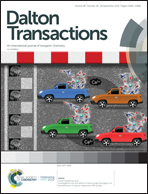Structural, kinetics and mechanistic studies of transfer hydrogenation of ketones catalyzed by chiral (pyridyl)imine nickel(ii) complexes†
Abstract
The chiral synthons (S-)-1-phenyl-N-(pyridine-2-yl)ethylidine)ethanamine (L1), (R-)-1phenyl-N-(pyridine-2-yl)ethylidine))ethanamine (L2) (S)-1-phenyl-N-(pyridine-2-yl methylene) ethanamine (L3), and (R)-1-phenyl-N-(pyridine-2-yl methylene) ethanamine (L4) were synthesized in good yields. Treatments of L1–L4 with NiBr2(DME) and NiCl2 precursor afforded dinuclear complexes [Ni2(L1)4-μ-Br2]NiBr4 (Ni1), [Ni2(L2)4-μ-Br2]NiBr4 (Ni2), [Ni2(L3)4-μBr2]Br2 (Ni3), [Ni2(L4)4-μ-Br2]NiBr4 (Ni4) and [Ni(L4)2Cl2] (Ni5). The identities of the compounds were established using NMR, FT-IR and EPR spectroscopy, mass spectrometry, magnetic moments, elemental analysis and single crystal X-ray crystallography. The dinuclear dibromide nickel complexes dissociate into mononuclear species in the presence of strongly coordinating solvents. Compounds Ni1–Ni5 displayed moderate catalytic activities in the asymmetric transfer hydrogenation (ATH) of ketones, but with low enantiomeric excess (ee%). Both mercury and substoichiometric poisoning tests pointed to the homogeneous nature of the active species with the partial formation of catalytically active Ni(0) nanoparticles. Low resolution mass spectrometry analyses of the intermediates supported a dihydride mechanistic pathway for the transfer of hydrogenation reactions.



 Please wait while we load your content...
Please wait while we load your content...